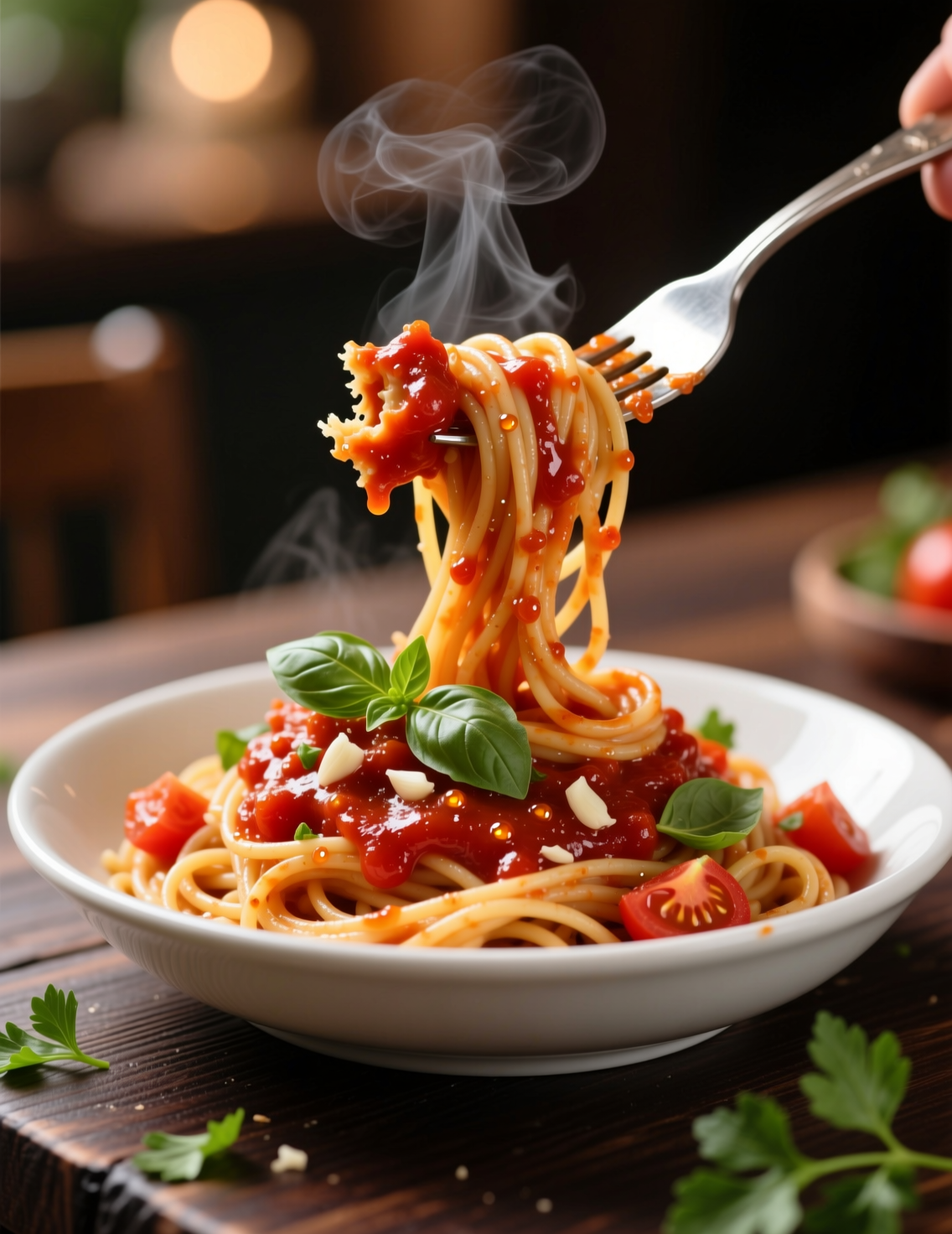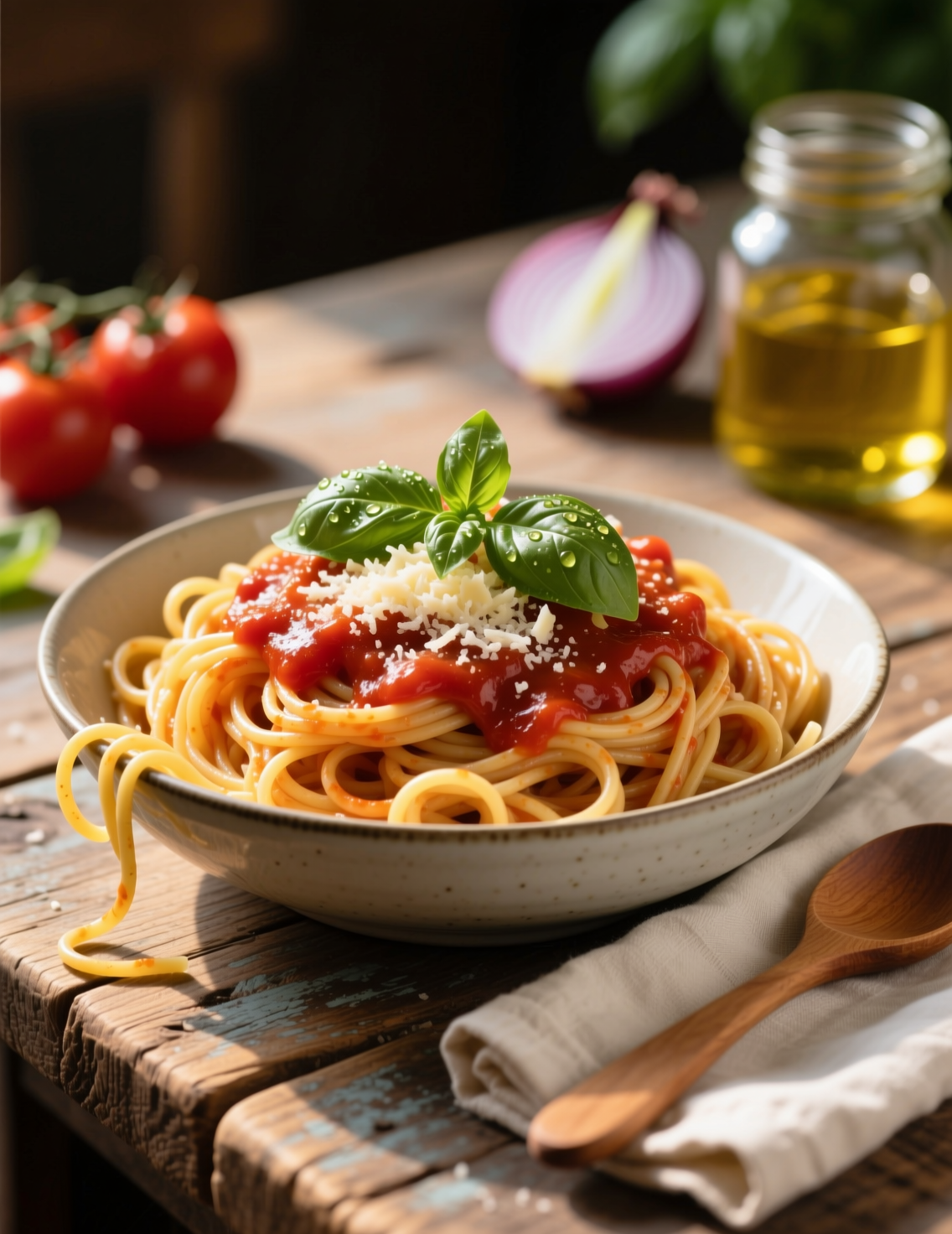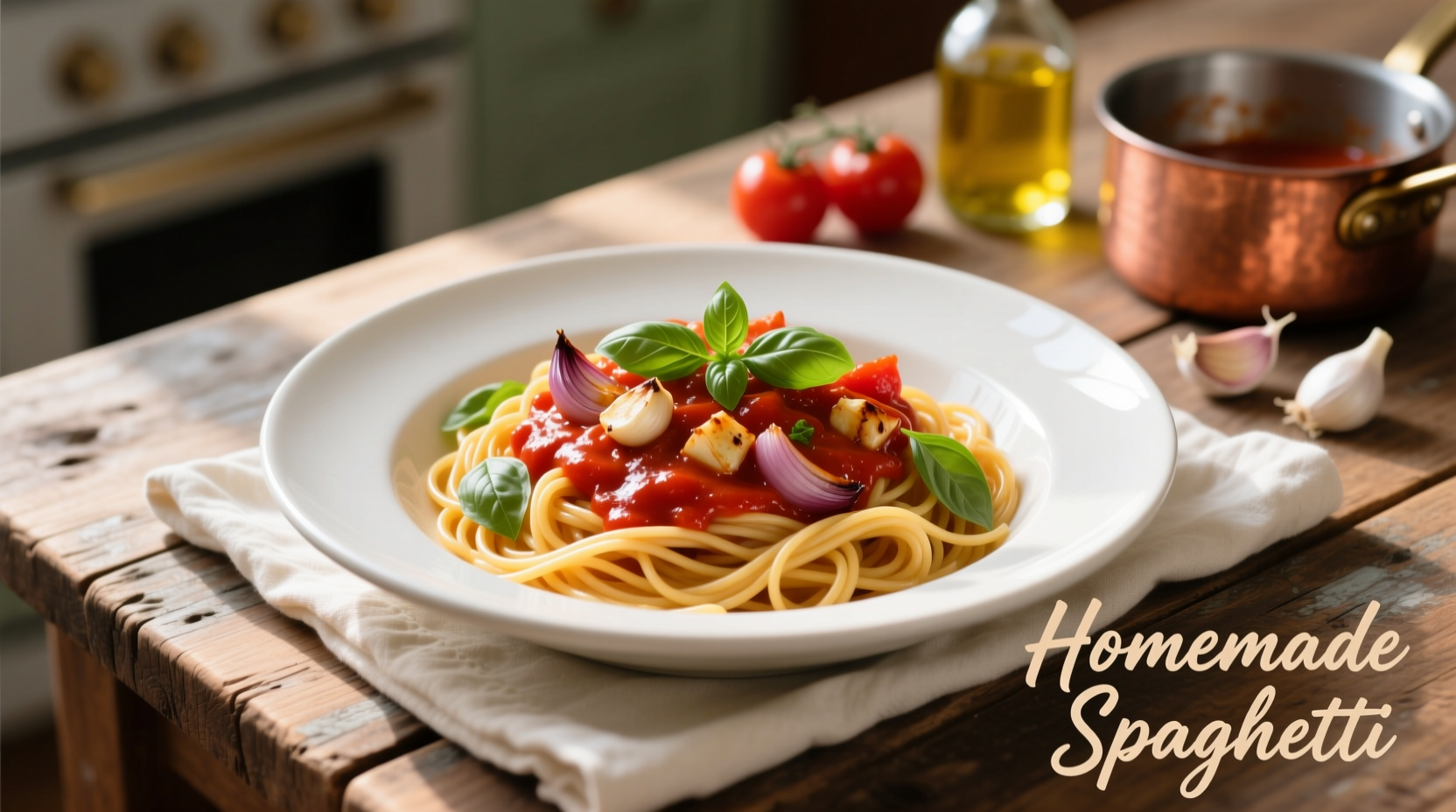Few things hit the soul quite like a rich, aromatic spaghetti sauce simmerin’ on the stove. Not the jarred stuff—real, homemade goodness that tastes like it’s been perfected over decades. Today we’ll dive into a recipe that serves four, but more importantly, I’ll give you the behind-the-scenes insights that pros swear by to make a sauce unforgettable.
Why Homemade Spaghetti Sauce Beats Store-Bought
Store-bought sauces are convenient, sure, but they can’t replicate the depth you get from layering flavors yourself. Most commercial sauces rely heavily on sugar, preservatives, and thickeners to mimic richness. Research shows homemade tomato sauces retain more antioxidants like lycopene, especially when slow-cooked with olive oil. That’s not just better taste—it’s actual health benefits.
Real pros know that building a sauce is about patience and layering. Garlic, onions, herbs, and a pinch of sugar at the right moment can completely change the sauce’s profile. You’ll notice that even small tweaks—like the timing of adding fresh basil—can make the sauce taste brighter or more mellow.
Ingredients You’ll Need
Here’s a breakdown of what makes this sauce sing:
- 2 tablespoons extra virgin olive oil
- 1 medium yellow onion, finely chopped
- 3 cloves garlic, minced
- 1 can (28 oz) whole peeled tomatoes, crushed by hand
- 2 tablespoons tomato paste
- 1 teaspoon sugar (optional, depends on tomato acidity)
- 1 teaspoon dried oregano
- 1 teaspoon dried basil
- 1/2 teaspoon red pepper flakes
- Salt and black pepper to taste
- Fresh basil leaves for garnish
The trick is to choose tomatoes that are firm, sweet, and slightly tangy. San Marzano tomatoes are often recommended by Italian chefs for their natural sweetness and low acidity. But honestly, locally-grown vine-ripened tomatoes can outperform any imported brand if cooked right.

Step-by-Step Preparation
Step 1: Sweating the Aromatics
Heat your olive oil over medium-low heat. Add onions and a pinch of salt, then sweat them until translucent—not browned. Toss in garlic for the last 30 seconds to prevent burning. This step might seem simple, but it’s foundational. If your onions scorch, the whole sauce will taste bitter.
Step 2: Building Tomato Flavor
Add the crushed tomatoes and tomato paste. Stir well and bring to a gentle simmer. At this stage, your sauce is bland. That’s normal. The magic happens in the slow cooking. Professionals often simmer sauces for 45 minutes to an hour. This reduces water content and concentrates flavors.
Step 3: Layering Herbs and Spices
Add oregano, dried basil, and red pepper flakes. Salt gradually as it simmers; over-salting at the beginning can’t be fixed later. I like to taste every 10 minutes and adjust. Many chefs do a trick—adding a tiny pinch of sugar if the sauce tastes acidic. It’s subtle but essential.
Step 4: The Art of Simmering
Keep the sauce at a low simmer, uncovered, stirring occasionally. This allows moisture to evaporate and flavors to meld. Some experts add a splash of red wine or balsamic vinegar for extra depth. It’s not mandatory, but it creates a nuanced tang that jarred sauces rarely achieve.
Step 5: Finishing Touches
Just before serving, tear fresh basil leaves and stir them in. Avoid cooking them too long—they’ll lose aroma. A drizzle of high-quality olive oil right at the end enhances mouthfeel and richness. If you’re feeling bold, a small pat of butter can round out acidity, giving it a velvety texture.
Common Mistakes and How to Avoid Them
Many people overcook garlic, which turns it bitter. Others add herbs too early, killing fresh aroma. Over-thickening the sauce is another trap; it should coat the pasta, not glue it together. And yes, under-seasoning is more common than you think—taste frequently, adjust incrementally.
Pro tip: if you make the sauce a day ahead, flavors deepen overnight. Refrigerate in an airtight container. Reheat gently on low heat, stirring occasionally. Many chefs swear a 24-hour rest period transforms an okay sauce into one that could win contests.
Serving and Pairing
This sauce works with all kinds of pasta, but spaghetti, linguine, or tagliatelle are classics. Toss freshly cooked pasta in the sauce rather than pouring sauce on top—it ensures every strand is coated. Top with fresh grated Parmigiano-Reggiano or Pecorino Romano. Add a pinch of chili flakes for heat if desired.
For side pairings, garlic bread or a simple arugula salad balances richness. A medium-bodied red wine, like Chianti or Sangiovese, complements the tomato acidity and herbs.
Variations for Professionals
Experimenting with ingredients is key to mastery:
- Meat-enhanced: Brown ground beef, pork, or Italian sausage before adding onions. Deglaze the pan with a splash of wine to retain flavor.
- Vegetable-rich: Add finely diced bell peppers, carrots, or mushrooms for sweetness and texture. Sauté them with onions at the start.
- Creamy touch: Stir in a few tablespoons of heavy cream or mascarpone just before serving for a silky, mellow sauce.
Each variation can cater to different palates without compromising the core flavor. Professionals often adjust these ratios according to season, tomato acidity, and customer preference.
The Science Behind a Great Sauce
Tomatoes are rich in lycopene, a carotenoid with antioxidant properties. Cooking actually increases lycopene availability, especially with some fat present. Olive oil acts as a solvent, making the lycopene more bioavailable. Herbs like oregano and basil contain polyphenols that add both flavor and minor health benefits. Understanding these details allows a cook to manipulate both taste and nutritional value intelligently.
Temperature control is another scientific factor. Simmering too hard breaks down pectin too quickly, leading to a watery, flat sauce. Low and slow cooking maintains a balance between viscosity and flavor extraction.
Storage and Freezing Tips
Homemade sauce freezes exceptionally well. Let it cool completely before transferring to freezer-safe containers. Portioning into 1–2 cup servings prevents wastage. For long-term storage, consider vacuum-sealing. Defrost slowly in the fridge to maintain texture. Avoid microwaving straight from frozen—it can degrade delicate flavors.

Addressing Common Misconceptions
Some believe fresh tomatoes are always superior, but canned tomatoes from peak season often outperform off-season fresh ones. Another myth: longer cooking always equals better flavor. In reality, too long on high heat can caramelize sugars excessively and produce bitterness. Lastly, salt early or late? Both have merit, but gradual seasoning gives more control over final taste.
Emerging Trends in Spaghetti Sauce
Plant-based and allergen-free adaptations are rising. Chefs use lentils, mushrooms, or textured vegetable protein to create hearty, satisfying sauces. Some upscale kitchens even roast tomatoes before sauce-making for smoky undertones. Others incorporate umami boosters like nutritional yeast or miso paste. These methods appeal to modern palates without sacrificing traditional flavor.
Final Thoughts and Recommendations
A truly tasty homemade spaghetti sauce is never rushed. Layering flavors, understanding ingredient timing, and balancing acidity with sweetness or fat is essential. Taste often, adjust lightly, and don’t fear small improvisations.
For professionals, the key takeaway is understanding that sauce is not just a topping—it’s an experience. Each step, from sweating onions to finishing with fresh basil, contributes to depth and authenticity. Store wisely, serve passionately, and remember: your sauce should feel alive, not just poured.
This recipe for 4 servings is your foundation. Double or triple it, experiment with meats, vegetables, or herbs, and make it your signature. Master these techniques, and you’re not just making spaghetti—you’re crafting an Italian masterpiece, one simmer at a time.
FAQs
What type of tomatoes are best for this spaghetti sauce?
San Marzano or ripe, locally-grown vine tomatoes work best.
Can I make this sauce ahead of time?
Yes, it tastes even better after resting 24 hours in the fridge.
How long should I simmer the sauce?
Simmer low and slow for 45–60 minutes for full flavor.
Should I add sugar to the sauce?
Optional—just a pinch if tomatoes are too acidic.
Can I freeze homemade spaghetti sauce?
Yes, in airtight containers or vacuum-sealed portions for months.
Is it necessary to use fresh basil?
Fresh basil at the end gives aroma; dried works during cooking.
Can I make this sauce with meat?
Absolutely—brown beef, pork, or sausage before onions.
How do I avoid bitter garlic in the sauce?
Add garlic last and cook gently for 30 seconds without browning.
What pasta goes best with this sauce?
Spaghetti, linguine, or tagliatelle work best for coating.
Can I make a creamy version of this sauce?
Yes, stir in heavy cream or mascarpone at the end for silkiness.
Does cooking improve tomato nutrients?
Yes, slow cooking with fat boosts lycopene absorption.
Can I roast tomatoes before making the sauce?
Yes, it adds smoky depth and richer flavor.
How should I season the sauce?
Salt gradually and taste frequently; adjust herbs to preference.
Can I add extra vegetables?
Yes, diced peppers, carrots, or mushrooms enhance flavor naturally.
Is olive oil necessary for this sauce?
Yes, it adds richness and helps extract lycopene from tomatoes.

Mariana is a passionate home cook who creates delicious, easy-to-follow recipes for busy people. From energizing breakfasts to satisfying dinners and indulgent desserts, her dishes are designed to fuel both your body and hustle.
When she’s not in the kitchen, she’s exploring new flavors and dreaming up her next recipe to share with the Foodie Hustle community.

